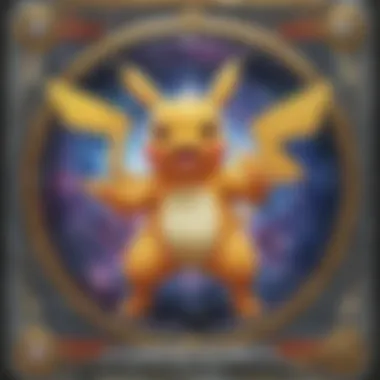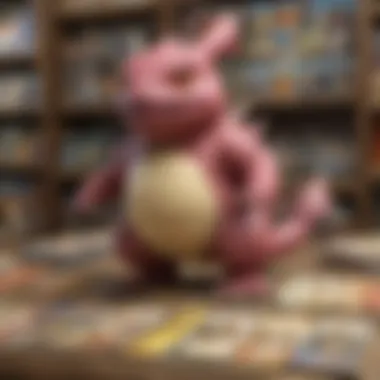Understanding the Value of Collectible Pokémon Cards


Intro
The Pokémon universe represents a vast and intricate landscape, especially when discussing the value of collectible cards. As fans and collectors know, each card is not merely a piece of cardstock but a gateway into history, nostalgia, and art. The monetary value of these Pokémon cards is shaped by an array of factors including rarity, condition, and community sentiment. For both prospective and seasoned collectors, understanding these variables is crucial.
Pokémon Game Overview
History of Pokémon Games
The Pokémon franchise began with the release of Pokémon Red and Green in Japan in 1996. Since its inception, it has expanded to include video games, anime, and a trading card game. These games laid the foundation for what would become a cultural phenomenon. The original aim was simple: catch Pokémon and battle them against others. This simple premise has birathed a complex world, where strategy, collecting, and competition thrive.
Evolution of Gameplay Mechanics
Throughout the years, Pokémon games have evolved significantly while retaining core gameplay elements. From the addition of online trading and battling to new features such as mega evolutions, the games Continue to be dynamic. Each new installment introduces mechanics that alter strategic considerations, making both games and cards a worthwhile study. Countless innovations aim to balance nostalgic elements with fresh content to attract new and returning fans alike.
Intro to Different Game Versions
The Pokémon franchise boasts multiple game versions, including main series titles like Pokémon Sword and Pokémon Shield, as well as spin-offs like Pokémon GO. Each version presents unique experiences that engage players differently. Species counting, team deployment, and battling environment all influence how players interact with Pokémon.
Tips and Strategies
Beginner's Guide to Pokémon Games
For beginners entering this vast world, a good starting point is to understand the fundamental gameplay. Focus should be on catching diverse Pokémon and leveling them up. Utilizing type advantages enhances battles, encouraging new players to discover Pokémon types like Water, Fire, and Grass. Knowledge of basic moves becomes critical for team success.
Advanced Gameplay Tactics
As players gain experience, strategy deepens. Skillful trainers recognize high-value cards with exceptional abilities and deploy them effectively. Being aware of meta-game trends gives collectors and players a competitive edge. Understanding moves that counter current trends is vital. Therefore, flexibility, adaptation and thorough research remains critical.
Team Building Strategies
Constructing a well-balanced team remains an art. Coordinating diverse Pokémon types alongside creating synergy between cards can turn the tide of battle. Rely on understanding the card values. Certain Pokémon cards carry more significance in the current market due to their rarity or popularity among collectors.
Character Spotlights
Featured Pokémon Profiles
Some Pokémon, such as Charizard or Pikachu, lore significant impact on the collecting world due to their widespread recognition and appeal. These characters not only populate conversations among collectors but also command higher prices in the market. Their direct effect on strategy aligns closely with their collectible value.
Analysis of Popular Characters
Popular Pokémon characters bring unique abilities that resonate with collectors. A character's role in battles is often reflected in the market. For instance, rare cards of legendary Pokémon may attract higher valuation due to their limited availability and perceived effectiveness in competitive play.
Impact of Characters on Gameplay
A Pokémon's functionality extends beyond battle capability. It heavily influences collector's interest and consolidates card values. Cards featuring essential characters create opportunities for novel strategies and an appreciative teeming fan base.
Latest News and Updates
Recent Game Releases
The continual release of new Pokémon games consistently refreshes interest among fans. Recent entries, like Pokémon Legends: Arceus, introduce players to various elements that later influence the collectible card market.
Patch Updates and Events
Regular patch updates keep gameplay engaged and equitable. Special events and tournaments organize a platform for collectors and players to interact, trade, and show off valuable cards. This dynamic can highten trading interest in cards particularly boosted through involvement.


Rumors and Speculations
As with any popular franchise, involved areas are often filled with speculation. Rumors of new cards or game mechanics encourage collectors and dedicated fans to stay sharp and current in their interests. Knowing about these rumors creates an excellent niche opportunity in the bustling marketplace, influencing demand steadily.
Final Thought: Understanding the social dynamics around Pokémon cards isn't just about stats - it’s a window into a community eagerly interactives with these beloved creatures. Embracing this authenticity cements one’s involvement in the broader Pokémon universe.
Prolusion to Collectible Cards
Collectible cards hold special recognition not just as items, but as cultural artifacts deeply rooted in gaming and fandom. In the Pokémon universe, these cards represent both nostalgia and investment opportunities, bridging gaps between multiple generations.
Definition of Collectible Cards
Collectible cards, in the context of Pokémon, are trading cards featuring various Pokémon characters, each with distinct attributes and designs. More than just simple pieces of cardstock, they embody an entire universe of strategy and community engagement. These cards can deepen one’s understanding of the game and provide match enhancements, which adds layers of value beyond their aesthetic appeal, allowing fans to actively participate in gameplay.
Overview of the Pokémon Card Market
The Pokémon card market has grown exponentially since its inception in the late 1990s. What started as a simple card game has evolved into a lucrative market driven by collectors and players alike. Cards like the first edition base set hold notable value and popularity in the trading marketplace. A combination of nostalgia and community fosters an ongoing demand for these items, making it crucial to understand their market dynamics for collecting enthusiasts.
The financial implications cannot be understated. Speculation about trends can shift significantly based on scarcity and condition. Collectors often scan platforms like Reddit and Facebook groups to stay updated on their collecting strategies.
The Pokémon card market not only encapsulates a game; it also captures collectors' hearts, serving both as an emotional and financial investment.
In summary, a careful consideration about collectible cards lays the groundwork for understanding their intricate landscape, which serves both as a hobby and a potential asset.
Factors Influencing Card Value
The value of Pokémon cards is shaped by a multitude of factors. These influences encompass rarity, condition, historical significance, and current market trends. Understanding these elements is crucial for collectors aiming to navigate the dynamic landscape of collectible cards. Each factor has its own merits and complexities.
Rarity and Availability
Rarity plays a pivotal role in determining the value of collectible Pokémon cards. Cards that are hard to find naturally attract more collectors' interest. High demand combined with limited supply can drive prices up significantly. Limited edition cards from specific sets often fetch higher prices. In contrast, cards produced in bulk are generally less valued.
Availability also affects both novices and seasoned collectors. Cards coming into the market in small quantities create urgency. This leads buyers to be more willing to part with higher sums when competition heats up. Some collectibles become so scarce that they become symbols of status in collector communities.
Condition and Grading
Understanding Grading Systems
Grading systems assess the quality of Pokémon cards. THese systems, like PSA or BGS, establish a clear transparency on the condition. A card's grade can vastly influence its market value. Understanding these grading tiers is integral to determining a card's worth. A properly graded card opens up opportunities. Collectors can buy, sell, and trade with confidence. There’s peace in knowing what one is handling.
The grading scales have specific benchmarks. They range from poor, with visible damage, to gem mint, describing cards in pristine condition. The higher the grade, the higher the value generally is. Grading creates an additional layer in the collecting experience and it can officially document the authenticity.
The Impact of Condition on Value
Condition impacts value significantly. A well-maintained card will invariably be worth more than one that is damaged or worn. There are different aspects to assess when evaluating condition, including surface quality, edges, and centers. Minor imperfections can lead to a decrease in value. Simply owning a valuable card does not guarantee richness; maintaining it leverages its true potential.
Collectors must be wise about how cards are stored and displayed. The right measures can ensure a card retains its top condition. Opting for sleeve protections and avoiding hot, humid environments are just examples. Even with slight condition differences, the price variations can be substantial.
Historical Significance of Cards
Pokemon cards with historical importance can have a strong value impact. Certain cards coinciding with major releases or anniversaries often see a surge in interest. Consider how the first edition Charizard card has skyrocketed in status. Its nostalgic ties resonate among collectors, making it notable. Card history informs collectors not just about their value but their journey through the Pokémon universe. That background genuine connections enhance sentimental value.
Current Market Trends
Popular Series and Editions
The Pokémon card market shifts with trends. Popular series from the Trading Card Game can seemingly govern current demands. Cards from beloved sets, like the Base Set or the Shining Legends, generally maintain higher value due to nostalgic feelings attached. Market interest also swings positively on new set releases. Often, when fresh card sets are introduced, older cards experience valuation shifts as collectors fill their collections.


New series can come with their special features or attributes, reassessing values whether higher or lower. Understanding what series is hot is vital for optimizing collector investments. Thus, securing cards from trending series can enhance personal value metrics.
Influence of Media on Card Value
Media influence extends beyond card games and includes television series, films, and merchandise. New productions can increase collector interest significantly. For instance, when a new movie features certain Pokémon cards, interest grows, thus increasing value too. Whether animated series fandoms or merchandise tie-ins, the media can create bursts in popularity influencing market dynamics.
Collecting Strategies for Value Generation
Collecting Pokémon cards can be an enthralling endeavor. This section emphasizes strategies that allow collectors to maximize the monetary potential of their cards. It explores how to identify valuable cards and provides valuable guidelines for buying and trading. Adopting effective strategies not only enhances collection quality but is also pivotal for substantial long-term value generation.
Identifying Valuable Cards
Recognizing valuable Pokémon cards is a primary step that demands attention and insight. The sounds of mild buzz in collector communities allude to certain cards gaining popularity, primarily due to their rarity or unique implications. Not every card has the same appeal; discernment is essential. Here are key factors to guide the identification process:
- Rarity: Cards printed in limited quantities often hold more value. Keep an eye on first edition cards or those marked as promotional.
- Popularity: Certain Pokémon, like Pikachu and Charizard, command higher demand. When focusing your collection, prioritize cards featuring well-loved characters.
- Tournament Viability: Cards that play a pivotal role in the competitive scene may derive additional value from collectors who are also players. Changes in the competitive landscape can directly affect value.
- Special Features: Cards featuring unique art styles, holographic prints, or special mechanics usually attract collectors' attention. Pay distinct attention to these design elements.
Buying and Trading Tips
Engaging in the buying and trading of Pokémon cards comes with its nuances. Navigating the market can yield both risks and rewards. The following tips can facilitate smoother transactions and ensure you secure valuable additions to your collection:
- Knowledge is Power: Stay updated with pricing trends and market demand. Websites like eBay often provide price benchmarks to deter overpaying.
- Utilize Online Marketplaces: Platforms such as Reddit and specific Facebook groups are rich with opportunity to spot good deals. While deals can sometimes shift rapidly, persistence can lead to hidden gems at reasonable prices.
- Trade Smartly: Engage in trades with careful consideration. Equally important is taking into account collector sentiment as specifics of a card’s current value might blur the lines between personal value and market value.
- Connect with Peers: Form connections within the collector community. This could lead to mutual advancement through tips, collecting advice, and sharing insights on market movement.
- Document Your Collection: Keeping an inventory of your cards, including their acquisition details, can help track your collection's progress and historical value. Using a simple spreadsheet could suffice for this role.
Almost any transaction made should reflect a healthy level of due diligence. Always verify authenticity to avoid counterfeits; the consequences can impact long-term value.
Follow these approaches with diligence. Keep analytical thinking in focus while following your passion for Pokémon collectibles. Set criteria that spark excitement rather than impulse. Strategic collection improvement ensures that every card stays significant and valuable in your Pokémon journey.
Notable High-Value Pokémon Cards
The Pokémon trading card game has generated numerous high-value cards over the years. These cards are not just collectibles but represent significant monetary and historical importance within the Pokémon community. Understanding notable cards helps collectors make informed decisions, whether buying, selling, or trading. High-value cards often have unique features, limited availability, or belong to significant sets, making them appealing to collectors and investors alike.
Iconic Cards and Their Worth
First Edition Holographic Cards
First Edition Holographic Cards stand out for their unique characteristics. These cards feature a holographic finish that gives a shimmering effect when viewed at certain angles. More importantly, they are part of the initial print run of Pokémon cards, released in 1999. Their rarity stems from being one of the first Pokémon sets, making them highly sought after. Collectors often consider these cards an investment because they typically appreciate in value over time.
A first edition holographic card is not just any card; it represents a moment in the inception history of Pokémon. Some iconic characters such as Charizard hold extraordinary demand and have sold for thousands of dollars at auctions. Yet, their high worth is not just about being rare. They evoke nostalgia among older fans while attracting newcomers in search of prized possessions.
One disadvantage is the high cost to acquire. Some collectors find it difficult to purchase these at fair market value, often leading to inflation and fakes circulating in the market.
Promotional Cards with Limited Release
Promotional Cards with Limited Release carry their own unique features and appeal. These cards are often created for specific events like tournaments, anniversaries, or special promotions. Due to their limited nature, they are considerably less available than standard cards, often making them more valuable when sold among collectors.
These cards hold historical significance aside from just monetary worth. For instance, cards released to commemorate the Pokémon 20th anniversary are highly prized among fans. They highlight a sense of belonging to specific moments in the Pokémon timeline. Collectors see them as a way to anchor themselves to pivotal moments of the franchise.
On the downside, their restricted release can mean challenging availability. Not all will find the opportunity to acquire these, which may create gaps in collections, frustrating dedicated fans.
Auction Insights and Record Sales
Understanding auction insights and record sales elevates knowledge in the art of card collecting. Auctions not only reflect current market value trends but also expose collectors to competition. Rare cards can often sell for extravagant prices at locations like eBay or through specialized auctioneers. Auctions give insight into collector sentiment and liquidity within the market.
Various factors contribute to the ever-changing results of auction sales. Recent records have shown that items once considered worn or damaged can fetch astonishing amounts if they come from a famed lineage or historical event. Tracking auction results, therefore, becomes an essential strategy for collectors wanting to gain a mathematical angle on collectible value assessments and potential increases in their card collections.
The Role of Collector Communities


Collector communities play a crucial role in the dynamics of the Pokémon card market. They act as hubs of information, networking, and collective enthusiasm, which can significantly influence card values. Therefore, understanding these communities offers insights into market behavior while also empowering collectors to make informed decisions.
Online Platforms and Marketplaces
The Importance of Digital Space
In today's digital world, online platforms such as eBay, TCGPlayer, and various dedicated Pokémon forums have become vital for buyers and sellers alike. These platforms provide accessibility to a broader audience, offering diverse options for trading, buying, or selling cards.
Key Features of Online Marketplaces
- User-friendly Interfaces: Most sites offer convenient search and filter tools, allowing users to quickly locate the cards they seek.
- Price Tracking: Many platforms enable collectors to view historical data on card sales, helping them understand value trends.
- Feedback Systems: Buyer and seller ratings create a trustworthy environment, crucial for high-value transactions.
Engaging in these online spaces not only helps traders find rare cards but creates a social culture among Pokéfanatics who can exchange ideas and strategies. Active engagement in community forums can sometimes lead to the discovery of valuable information that may not be readily available in market data alone.
Events and Conventions
Value of Community Gatherings
Collector events and conventions are hotspots for Pokémon enthusiasts. These gatherings allow individuals to meet face-to-face, fostering relationships built on shared interests in collectible cards.
Benefits of Attending Events
- Networking Opportunities: Collectors can share tips, showcase cards, and establish connections, enabling ongoing discussions beyond the event.
- Examining Cards Physically: Attendees can inspect cards' conditions better than from online images, facilitating informed trading decisions.
- Educational Content: Many conventions offer panels or workshops covering market trends, valuation tips, and grading, benefiting both novice and experienced collectors.
Local meet-ups and larger conventions like Pokémon World Championships also serve to boost community morale. They promote the sharing of databases, expertise in card grading, and new collection strategies while also encouraging passionate discussions about recent market fluctuations.
By recognizing the value of collector communities, investors can enhance their strategies and knowledge, ultimately affecting the appreciation of their collections.
Future Trends in Collectible Card Valuation
Understanding the future trends in collectible card valuation is crucial for anyone involved or interested in the Pokémon card market. Factors like technological advancements and changes in collector behavior have the potential to alter how cards are valued and traded, making this a relevant topic.
As trends shift, they affect buying habits and overall demand. Keeping watch on these trends can help collectors make informed decisions regarding their collections. Likewise, sellers can better position their offerings in the marketplace by understanding upcoming shifts. Therefore, insights into the potential future state of collectible cards are indispensable for maximizing potential investments.
Technological Influences
Technological advancements play a significant role in shaping the evolution of collectible card valuation. Methods such as digital grading tools and platforms enable quick assessment of a card’s worth more efficiently than traditional means. A collector looking to price their cards might understandably benefit from leveraging these technologies.
Blockchain is adding a layer of authenticity that was not as easily feasible previously. Cards can have a reliable digital signature, confirming their authenticity and ownership history. Tools and applications emerge constantly, allowing collectors to track pricing trends more considerably, facilitating market analysis and eliminating some of the guesswork in valuation.
Here are some technological tools influencing collectible cards:
- Digital trading platforms for easier access to marketplace and pricing
- Augmented reality applications to present cards interactively
- Sophisticated software tools for pricing evaluation
"Technology continuously reshapes how we perceive and cultivate our card collections onscreen and in real-time."
Sustainable Collecting Practices
As the world shifts towards sustainability, collectors are increasingly considering the environmental implications of their hobbies. Sustainable collecting practices encourage a responsible approach toward attaining and maintaining card collections. Methods such as purchasing from ethical distributors or avoiding wasteful packaging are among the practices gaining traction.
Moreover, sustainable collecting includes the concept of maintaining longevity with collectibles instead of over-saturating the market, aiming for lasting value rather than impulsive buying. Awareness about the circular economy is starting to resonate. Collectors might find secondary markets appealing for trading, which helps minimize new production demands while maximizing value from existing cards.
- Ethical sourcing of cards can appeal to collectors committed to sustainability needs.
- Engaging in local trading events helps maintain community values and minimizes carbon footprints too.
Both collectors and the broader Pokémon-focused community can thus embody sustainable practices which might grow in importance over time, shaping potential values associated with Pokémon cards.
Finale
In summary, this article has shed light on the intricate factors affecting the value of Pokémon collectible cards. The ever-evolving market relies not only on rarity and condition but also on fluctuating trends and collector sentiments. Understanding these key elements is crucial for anyone navigating this complex landscape.
Summarizing Key Points on Card Value
- Independent Study of Card Rarity: The rarity of a card directly influences its monetary value. Cards that are harder to find often see higher prices in the market.
- Grading Systems: The condition plays a significant role in value. Understanding grading can help collectors identify what to prioritize when buying or trading.
- Historical Context: Some cards have backgrounds that make them more valuable. The story or era from which a card originates can add to its allure.
- Market Trends: Keeping abreast of current trends, such as which card sets or characters are trending, sets serious collectors apart.





